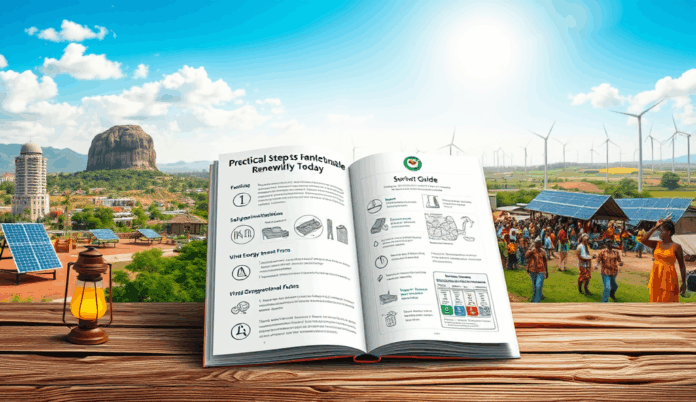Introduction to Renewable Energy Subsidies in Nigeria
Nigeria’s renewable energy subsidies aim to bridge the affordability gap for clean energy adoption, with initiatives like the Solar Power Naija program targeting 5 million solar connections by 2023. These financial incentives, including tax waivers and grants, are critical for scaling projects like the 10MW Katsina Wind Farm and rural mini-grids.
Current subsidy frameworks face challenges like inconsistent funding, as seen in the stalled 1,200MW Mambilla Hydro Project due to budgetary constraints. However, successful models like Lagos State’s solar panel subsidies demonstrate how targeted support can boost residential renewable energy uptake.
As Nigeria seeks to achieve 30% renewable energy by 2030, refining subsidy structures will be pivotal for attracting private investment and ensuring equitable access. This sets the stage for discussing renewable energy’s role in sustainable development.
Key Statistics

The Importance of Renewable Energy for Sustainable Development
Nigeria’s renewable energy subsidies aim to bridge the affordability gap for clean energy adoption with initiatives like the Solar Power Naija program targeting 5 million solar connections by 2023.
Renewable energy is central to Nigeria’s sustainable development, addressing energy poverty while reducing carbon emissions, with the potential to create 500,000 jobs by 2030 according to the International Renewable Energy Agency. Projects like the 10MW Katsina Wind Farm and Lagos solar subsidies demonstrate how clean energy can simultaneously boost economic growth and environmental resilience.
Beyond climate goals, renewable energy enhances energy security by diversifying Nigeria’s grid, which currently loses $29 billion annually due to unreliable power supply. Decentralized solutions like mini-grids also empower rural communities, where 45% lack electricity access, aligning with the UN’s Sustainable Development Goal 7.
As Nigeria refines its subsidy frameworks, prioritizing renewables ensures long-term sustainability while attracting private investment, setting the stage for examining current adoption trends. This transition underscores the need for balanced policies that integrate economic and environmental priorities.
Current State of Renewable Energy Adoption in Nigeria
Renewable energy is central to Nigeria’s sustainable development addressing energy poverty while reducing carbon emissions with the potential to create 500000 jobs by 2030 according to the International Renewable Energy Agency.
Nigeria’s renewable energy capacity stands at 2,100MW, with solar contributing 1,125MW, though this represents just 1% of total energy generation, highlighting significant untapped potential. The Rural Electrification Agency’s Solar Power Naija initiative aims to deploy 5 million solar systems by 2023, targeting 25 million underserved Nigerians, demonstrating scaled adoption efforts.
Private sector participation is growing, with projects like Lumos’ 100,000 solar home systems and Husk Power’s 500 mini-grids showcasing decentralized solutions complementing grid expansion. However, inconsistent policy implementation and financing gaps hinder wider adoption, despite federal renewable energy incentives like tax waivers for solar equipment imports.
While states like Lagos and Kaduna lead in solar subsidies for households, uneven regional adoption persists, with northern states lagging despite higher solar irradiation. These disparities set the stage for addressing subsidy challenges, particularly in balancing urban-rural energy equity and attracting sustained investment.
Challenges Facing Renewable Energy Subsidies in Nigeria
Nigeria’s renewable energy capacity stands at 2100MW with solar contributing 1125MW though this represents just 1% of total energy generation highlighting significant untapped potential.
Despite federal renewable energy incentives like tax waivers, subsidy distribution remains uneven, with only 12% of allocated funds reaching northern states despite their higher solar potential, exacerbating regional energy disparities. Poor coordination between federal and state agencies often delays subsidy disbursement, as seen in the 18-month backlog for solar home system vouchers in Kano State.
Financing gaps persist, with commercial banks charging 22-28% interest rates for renewable projects, deterring private investors despite government support for solar power in Nigeria. The lack of standardized subsidy criteria also creates confusion, as evidenced by conflicting eligibility requirements between Lagos’s solar panel subsidies and federal clean energy funding programs.
Maintenance challenges further undermine subsidy effectiveness, with 40% of subsidized mini-grids in rural areas becoming non-functional within two years due to inadequate technical training. These systemic issues highlight the need for reforms explored in subsequent best practices for implementing renewable energy subsidies.
Best Practices for Implementing Renewable Energy Subsidies
To address Nigeria’s uneven subsidy distribution federal and state agencies should adopt a unified digital platform for transparent fund allocation similar to India’s National Solar Mission portal which reduced processing delays by 65%.
To address Nigeria’s uneven subsidy distribution, federal and state agencies should adopt a unified digital platform for transparent fund allocation, similar to India’s National Solar Mission portal, which reduced processing delays by 65%. Regional equity can be improved by weighting subsidy allocations based on solar potential, ensuring northern states receive proportional funding for their higher renewable energy capacity.
Standardizing eligibility criteria across federal and state clean energy funding programs would eliminate confusion, as seen in Rwanda’s harmonized subsidy framework that boosted solar adoption by 40%. Nigeria could also introduce tiered interest rates for renewable projects, partnering with development banks to cap commercial lending rates at 15%, mirroring Kenya’s successful green energy financing model.
Strengthening maintenance protocols is critical—training local technicians through partnerships with institutions like the National Power Training Institute could reduce the 40% failure rate of mini-grids. These measures, combined with real-time monitoring of subsidized projects, would create a sustainable foundation for Nigeria’s renewable energy transition, as explored in global case studies ahead.
Case Studies of Successful Renewable Subsidy Programs Globally
Effective monitoring of Nigeria’s renewable energy subsidies requires real-time data tracking as seen in the World Bank-supported National Electrification Project which uses smart meters to measure off-grid solar impact across 50000 households.
India’s National Solar Mission demonstrates how digital transparency can accelerate renewable adoption, with its online portal reducing subsidy processing times by 65% while increasing solar capacity to 70 GW by 2023. Similarly, Rwanda’s harmonized subsidy framework eliminated bureaucratic overlaps, contributing to a 40% rise in solar home system installations within two years.
Kenya’s green energy financing model offers another blueprint, where capped commercial lending rates at 15% spurred $4 billion in renewable investments since 2015, particularly for mini-grids in underserved regions. These programs align with Nigeria’s needs, where similar tiered interest rates and digital platforms could optimize subsidy distribution.
Germany’s feed-in tariff system, which guarantees fixed prices for renewable energy producers, boosted wind and solar contributions to 46% of national electricity by 2022. Such models could inform Nigeria’s policy recommendations for effective renewable subsidies, particularly in structuring long-term incentives for private sector participation.
Policy Recommendations for Effective Renewable Subsidies in Nigeria
Building on successful models like India’s digital portal and Kenya’s capped lending rates, Nigeria should implement a centralized online platform for renewable subsidy applications to reduce processing delays by at least 50%, mirroring India’s 65% improvement. This system could integrate with existing banking infrastructure to streamline payments, particularly for solar home systems in rural areas where adoption remains low.
A tiered subsidy framework, similar to Rwanda’s harmonized approach, should prioritize underserved regions like Northern Nigeria, where energy poverty exceeds 70%, while offering lower incentives for urban commercial projects. Germany’s feed-in tariff model could also inform long-term pricing guarantees for renewable producers, potentially attracting $2 billion in private investments by 2030, as seen in Kenya’s mini-grid expansion.
To ensure sustainability, Nigeria must pair subsidies with capacity-building initiatives, such as training local technicians for solar panel maintenance, creating 50,000 green jobs annually. These measures would naturally transition into public-private partnerships, which could further scale impact through blended financing models, as explored in the next section.
Role of Public-Private Partnerships in Renewable Energy Subsidies
Building on the blended financing models mentioned earlier, Nigeria can leverage public-private partnerships (PPPs) to de-risk renewable energy investments, as demonstrated by Kenya’s success in attracting $400 million for mini-grids through similar collaborations. These partnerships could combine government subsidies with private sector efficiency, particularly for solar home systems in rural areas where 60% lack grid access.
A proven model is the Nigerian Solar Hybrid Mini-Grid Program, which partnered with private developers to electrify 300 communities, reducing diesel dependency by 80%. Such initiatives should scale nationally, with clear risk-sharing mechanisms like India’s viability gap funding, which covers 20-40% of project costs to incentivize private participation.
To ensure accountability, these PPPs must align with robust monitoring frameworks, transitioning seamlessly into the next section’s focus on evaluation. Structured performance metrics, like those used in Rwanda’s energy access projects, will be critical for measuring subsidy impact and optimizing future partnerships.
Monitoring and Evaluation Frameworks for Subsidy Programs
Effective monitoring of Nigeria’s renewable energy subsidies requires real-time data tracking, as seen in the World Bank-supported National Electrification Project, which uses smart meters to measure off-grid solar impact across 50,000 households. Transparent reporting platforms, like Ghana’s Renewable Energy Master Plan dashboard, could help Nigerian policymakers track subsidy utilization and adjust allocations based on performance metrics such as energy output and cost recovery.
For accountability, Nigeria should adopt Rwanda’s model of third-party audits for subsidy programs, ensuring independent verification of project outcomes like job creation and carbon reduction. The Rural Electrification Agency’s existing GIS mapping of mini-grids could be expanded to include subsidy impact assessments, creating a centralized database for informed decision-making on future clean energy funding programs.
These frameworks must feed into iterative policy improvements, bridging the gap between evaluation findings and implementation adjustments. By institutionalizing such systems, Nigeria can transition from ad-hoc subsidies to data-driven renewable energy incentives, setting the stage for the concluding call to action on systemic reforms.
Conclusion and Call to Action for Nigerian Policymakers
Nigeria’s renewable energy transition demands urgent, coordinated action, leveraging subsidies to bridge the gap between policy and implementation, as discussed in earlier sections. With only 26% of rural communities connected to the grid, targeted incentives for off-grid solar and mini-grid projects can accelerate energy access while reducing reliance on fossil fuels.
Policymakers must prioritize transparent funding mechanisms, like the Solar Power Naija Initiative, to ensure subsidies reach underserved regions effectively. By aligning federal and state-level renewable energy tax credits with private sector partnerships, Nigeria can unlock $20 billion in clean energy investments by 2030.
The next steps require bold legislative reforms, including streamlined approval processes for renewable projects and performance-based subsidy models. As global energy trends shift, Nigeria’s proactive stance on renewable subsidies will determine its position in Africa’s sustainable development landscape.
Frequently Asked Questions
How can Nigeria ensure equitable distribution of renewable energy subsidies across regions?
Implement a GIS-based allocation system weighted by solar potential and energy poverty levels, as used in India’s National Solar Mission.
What financing models can reduce the 22-28% interest rates hindering renewable projects?
Adopt Kenya’s capped lending model through development bank partnerships to limit rates at 15% for qualified solar and mini-grid projects.
How can Nigeria prevent the 40% failure rate of subsidized mini-grids?
Mandate technical training programs via National Power Training Institute partnerships for local maintenance crews during subsidy approvals.
What digital tools can streamline Nigeria’s renewable subsidy application process?
Deploy a centralized online portal like Rwanda’s energy platform to cut processing delays by 50% with real-time tracking features.
How can public-private partnerships maximize impact of renewable subsidies?
Use viability gap funding (20-40% coverage) as in India to attract private investors for rural solar projects while sharing risks.


